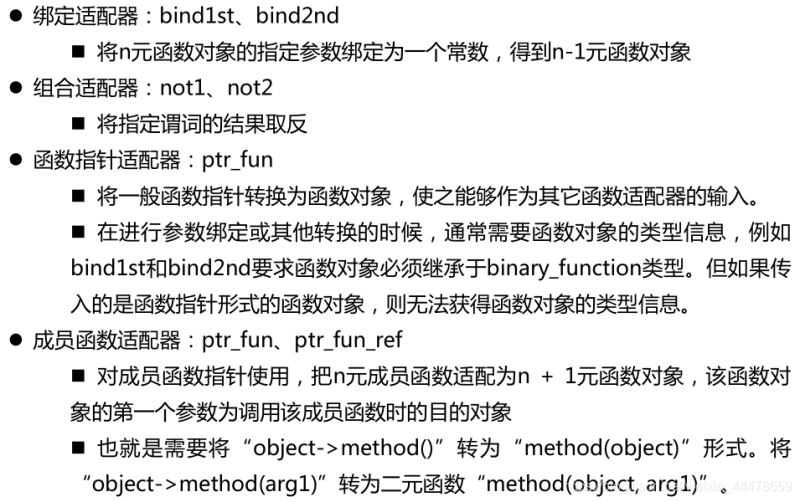C++:函數對象,STL提供的函數對象,函數適配器詳解
1 函數對象
1.函數對象是行為類似函數的對象。一個類對象,表現出一個函數的特征,即通過對象名+(參數列表)的方式使用一個類對象。
2.使用STL中提供的或自定義的迭代器和**函數對象,**配合STL的算法,組合出各種各樣的功能。
3.通過函數對象而不使用函數指針,可以增加通用性,提高效率。
4.函數對象概念:泛化的函數

①將普通函數作為函數對象:傳遞函數名
#include <iostream>
#include <numeric> //包含accumulate算法
#include <functional>
#include <vector>
using namespace std;
int mult(int a, int b) {
return a * b;
}
int main()
{
int a[] = { 1, 2, 3, 4, 5, 6, 7 };
const int N = sizeof(a) / sizeof(int); //用該式確定數組長度,定義為常量
cout << "所有數累乘為:" << accumulate(a, a + N, 1, mult) << endl; //將普通函數作為函數對象,傳遞函數名
//指針a,a + N也可以作為迭代器
return 0;
}
②將重載瞭()運算符的類的對象作為函數對象:傳遞”類名()”
#include <numeric>
#include <iostream>
using namespace std;
class MultClass {
public:
int operator () (int a, int b) const {
return a * b;
}
};
int main()
{
int a[] = { 1, 2, 3, 4, 5, 6, 7 };
const int N = sizeof(a) / sizeof(int); //確定數組a的長度
cout << "所有數乘積為:" << accumulate(a, a + N, 1, MultClass()) << endl; //傳輸方式是類名(),輸出5040
//指針a,a + N也可以作為迭代器
MultClass ss;
cout << ss(100, 100); //輸出10000
return 0;
}
2 STL提供的函數對象

1.系統提供函數對象幫助實現基本功能。
2.accmulate算法接受二元函數對象,transform算法接受一元函數對象。
①STL庫的multiplies
#include <iostream>
#include <functional>
#include <numeric>
using namespace std;
int main(){
int a[] = { 1, 2, 3, 4, 5, 6, 7 };
const int N = sizeof(a) / sizeof(int);
cout << accumulate(a, a + N, 1, multiplies<int>()) << endl;//通過STL自帶的函數對象multiplies實現乘法,註意要寫數據類型<int>
//指針a,a + N也可以作為迭代器
return 0;
}
②STL庫的二元謂詞greater
#include <iostream>
#include <algorithm>
#include <functional> //包含greater
using namespace std;
int main() {
int arr[] = { 24, 43, 5, 4, 62, 34, 7654, 22 };
const int N = sizeof(arr) / sizeof(int);
copy(arr, arr + N, ostream_iterator<int>(cout, "\t"));
cout << endl;
sort(arr, arr + N, greater<int>()); //包含在<algorithm>中,默認是升序
copy(arr, arr + N, ostream_iterator<int>(cout, "\t"));
return 0;
}
3 函數適配器
適配器顧名思義,讓函數適配算法。
Unary Predicate:一元謂詞
binary:二元的
bind:結合,(使)聯合在一起


①找出第一個大於40的數,註意用數組和vector都可以
#include <iostream>
#include <algorithm>
#include <functional>
#include <vector>
using namespace std;
int main()
{
int a[] = { 30, 40, 50, 90, 20, 10 };
const int N = sizeof(a) / sizeof(int);
int *c = find_if(a, a + N, bind2nd(greater<int>(), 40));
cout << *c << endl;
return 0;
}
一般使用數組初始化向量vector,後續操作更方便
int main()
{
int a[] = { 30, 40, 50, 90, 20, 10 };
const int N = sizeof(a) / sizeof(int);
vector<int> v (a, a + N); //用數組初始化vector
vector<int>::iterator p = find_if (v.begin(), v.end(), bind2nd(greater<int>(), 40) );
if (p == v.end())
cout << "找不到" << endl;
else
cout << *p << endl;
return 0;
}
find_if算法在STL中的原型聲明為: template<class InputIterator, class UnaryPredicate> InputIterator find_if(InputIterator first, InputIterator last, UnaryPredicate pred); 它的功能是查找數組[first, last)區間中第一個pred(x)為真的元素。 InputIterator、UnaryPredicate是用概念來做模板參數名
②利用prt_fun、not1、not2產生組合適配器
#include <iostream>
#include <functional>
#include <algorithm>
#include <vector>
using namespace std;
int g(int x, int y) { //實現類似greater的功能
return x > y;
}
int main()
{
int a[] = { 30, 90, 10, 23, 432, 656, 7, 78 };
const int N = sizeof(a) / sizeof(int);
vector<int> v(a, a + N);
auto p1 = find_if(v.begin(), v.end(), bind2nd(ptr_fun(g), 40)); //找第一個大於40的數
//ptr_fun將函數指針轉換為函數對象,bind2nd將40作為二元函數對象的第二個參數
if (p1 == v.end())
cout << "no element" << endl;
else
cout << *p1 << endl;
auto p2 = find_if(v.begin(), v.end(), not1(bind2nd(ptr_fun(g), 15))); //找第一個不大於15的數
//not1對一元函數對象取邏輯反,find_if找到第一個令bind2nd取false的值
if (p2 == v.end())
cout << "no element" << endl;
else
cout << *p2 << endl;
auto p3 = find_if(v.begin(), v.end(), bind2nd(not2(ptr_fun(g)), 15)); // 找第一個不大於15的數
//not2對二元函數取邏輯反
if (p3 == v.end())
cout << "no element" << endl;
else
cout << *p3 << endl;
return 0;
}
③成員函數適配器,類的成員函數要通過適配器轉換為普通函數對象
#include <iostream>
#include <vector>
#include <functional>
#include <algorithm>
using namespace std;
struct Car
{
int id;
Car(int id) {
this->id = id;
}
void display() const {
cout << "car " << id << endl;
}
};
int main() {
vector<Car*> pcars;
vector<Car> cars;
for (int i = 0; i < 5; i++)
pcars.push_back(new Car(i)); //push_back() 在Vector最後添加一個元素(參數為要插入的值)
for (int i = 5; i < 10; i++)
cars.push_back(Car(i));
cout << "elements in pcars: " << endl;
for_each(pcars.begin(), pcars.end(), mem_fun(&Car::display));//for_each算法對每一個迭代器范圍中的元素進行函數對象計算
//men_fun適配後函數對象的參數為"對象的指針"
cout << endl;
for_each(cars.begin(), cars.end(), mem_fun_ref(&Car::display));
//men_fun_ptr適配後函數對象的參數為"對象的引用"
cout << endl;
for (size_t i = 0; i < pcars.size(); ++i)
delete pcars[i];
return 0;
}
為什麼不能同全局函數一樣直接傳遞函數名而成員函數必須以 &類名::函數名 的方式,因為需要考慮static成員函數的情況。
mem_fun(member適配為function):將成員函數適配為普通函數對象,適配出來的函數需要對象的指針作為參數。
men_fun_ref:將成員函數適配為普通函數對象,適配出來的函數需要對象的引用作為參數。
總結
本篇文章就到這裡瞭,希望能給你帶來幫助,也希望您能夠多多關註WalkonNet的更多內容!
推薦閱讀:
- C++ vector容器 find erase的使用操作:查找並刪除指定元素
- C++ STL中五個常用算法使用教程及實例講解
- C++ accumulate函數詳細介紹和具體案例
- C++函數對象詳解附帶實例
- C++11中bind綁定器和function函數對象介紹